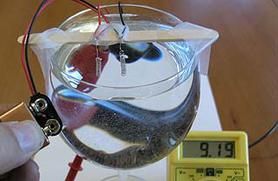What you'll need:
From Scitoys
- A popsickle stick or similar small piece of wood or plastic.
- A 9 volt battery clip.
- A 9 volt battery.
- Some transparent sticky tape.
- A glass of water.
- A volt meter.
- One foot of platinum coated nickel wire, or pure platinum wire.
Okay, so platinum coated nickel wire isn't exactly a household item. You can order one online for 15 bucks.
1. Cut and Wind the Wire
Alright. Let's get started. From SciToys:
The first step is to cut the platinum coated wire into two six inch long pieces, and wind each piece into a little coiled spring that will be the electrodes in our fuel cell. I wound mine on the end of the test lead of my volt meter, but a nail, an ice pick, or a coat hanger will do nicely as a coil form.
2. Ready the Battery
A little fancy finger-work here...
Next, we cut the leads of the battery clip in half and strip the insulation off of the cut ends. Then we twist the bare wires onto the ends of the platinum coated electrodes, as shown in the photo. The battery clip will be attached to the electrodes, and two wires will also be attached to the electrodes, and will later be used to connect to the volt meter.
3. The Popsicle Stick and Electrodes
The electrodes are then taped securely to the popsickle stick. Lastly, the popsickle stick is taped securely to the glass of water, so that the electrodes dangle in the water for nearly their entire length. The twisted wire connections must stay out of the water, so only the platinum coated electrodes are in the water.
4. Hook Up the Volt Meter
Now connect the red wire to the positive terminal of the volt meter, and the black wire to the negative (or "common") terminal of the volt meter. The volt meter should read 0 volts at this point, although a tiny amount of voltage may show up, such as 0.01 volts.
5. Voila. A Hydrogen Fuel Cell
Congrats, you've just built the future in your kitchen in about half the time it takes to watch The Office. Now you just have to use it:
To operate the fuel cell, we need to cause bubbles of hydrogen to cling to one electrode, and bubbles of oxygen to cling to the other. There is a very simple way to do this.
We touch the 9 volt battery to the battery clip (we don't need to actually clip it on, since it will only be needed for a second or two).
Touching the battery to the clip causes the water at the electrodes to split into hydrogen and oxygen, a process called electrolysis. You can see the bubbles form at the electrodes while the battery is attached.
Now we remove the battery. If we were not using platinum coated wire, we would expect to see the volt meter read zero volts again, since there is no battery connected.
The platinum acts as a catalyst, allowing the hydrogen and oxygen to recombine.
The hydrolysis reaction reverses. Instead of putting electricity into the cell to split the water, hydrogen and oxygen combine to make water again, and produce electricity.
For more detailed info on the battery and how it works, hop over to SciToys. And enjoy having the future of alternative energy in your kitchen.
